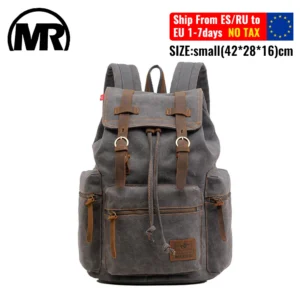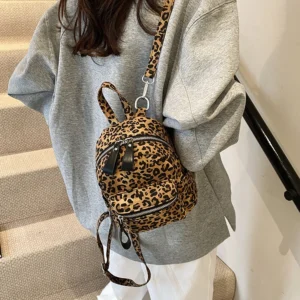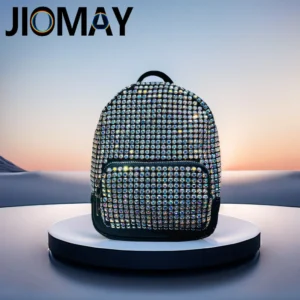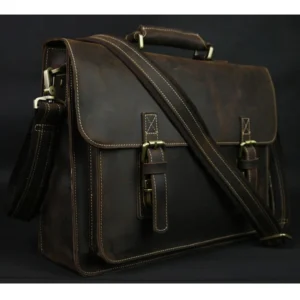Introduction: The Enduring Appeal of Leather for Daily Organization
Leather backpacks stand as timeless companions for the organized individual. Unlike their synthetic counterparts, leather offers natural structure that maintains its shape throughout years of daily use while developing character with age. The material’s inherent durability creates a stable foundation for keeping belongings systematically arranged, whether for professional settings or casual outings.
What makes leather particularly suited for organizational needs:
- Natural rigidity that prevents sagging and maintains compartment integrity
- Professional appearance that elevates even the most functional designs
- Structural stability that protects contents from impacts and compression
- Adaptability to modern organizational needs while maintaining classic appeal
Proper leather conditioning and waterproofing significantly extends the lifespan of these investment pieces, with quality leather goods often lasting decades rather than the few years typical of synthetic alternatives. This longevity aligns perfectly with the growing movement toward mindful consumption and investment in fewer, better things.
As organizational tools, leather backpacks have evolved from simple carryalls to sophisticated systems featuring padded laptop compartments, dedicated pockets for modern devices, and thoughtful storage solutions while maintaining their timeless aesthetic appeal. The wide variety of leather backpacks available today means there’s a perfect organizational solution for every lifestyle.
Key Benefits of Leather Backpacks for Daily Organization
Leather backpacks offer distinct advantages that directly enhance your daily organizational experience:
Superior structural integrity: Leather maintains its shape even when fully loaded, preventing items from shifting and becoming jumbled. This natural structure means pens stay in their holders and electronics remain secure in their designated sleeves.
Environmental resilience: Quality leather naturally resists light rain, dust, and everyday hazards that would quickly degrade synthetic materials. This protective quality extends to the valuable contents inside your backpack.
Professional versatility: Few materials transition as seamlessly between formal office environments and casual settings. A well-chosen leather backpack can serve as your organizational system for both board meetings and weekend excursions.
Personalized patina development: Unlike synthetic materials that deteriorate with age, leather develops a rich patina that tells the story of your daily journeys while becoming uniquely yours. This aging process enhances rather than diminishes its appeal.
Value retention: While the initial investment might exceed that of canvas or nylon options, leather’s longevity means the cost-per-use decreases significantly over time, often making it more economical in the long run.
The combination of these benefits creates an organizational tool that improves with age rather than requiring replacement. Choosing quality leather for bags is essential to maximize these advantages, as not all leather is created equal.
Understanding Leather Quality and Types for Informed Selection
To make an informed decision about a leather backpack for daily organization, understanding different leather types is essential:
Full-grain leather represents the highest quality, using the entire top layer of the hide with its natural grain intact. This type offers exceptional durability and develops a beautiful patina over time, making it ideal for daily use backpacks that will see years of service. The natural variations in the hide give each piece unique character while providing superior strength.
Top-grain leather comes next in the quality hierarchy, created by sanding away imperfections from the upper layer of the hide. While slightly less durable than full-grain, top-grain leather offers a good balance between quality and weight, with a more uniform appearance that some prefer for professional settings.
Genuine leather is a lower grade made from the layers remaining after top-grain is removed. Despite the name suggesting authenticity, genuine leather products typically have shorter lifespans and don’t develop the rich character of higher grades. For daily organizational needs, this material may show wear more quickly in high-stress areas.
Bonded leather should generally be avoided for daily use items. This material consists of leather scraps bound together with adhesives, offering minimal durability and poor aging characteristics.
| Leather Type | Durability | Weight | Patina Development | Best For | Price Range |
|---|---|---|---|---|---|
| Full-grain | Excellent | Heavier | Rich, distinctive | Lifetime investment pieces | $$$-$$$$ |
| Top-grain | Very good | Moderate | Good | Professional daily use | $$-$$$ |
| Genuine | Fair | Light | Limited | Occasional use | $-$$ |
| Bonded | Poor | Light | None | Avoiding | $ |
Tanning methods also affect leather properties significantly:
Vegetable-tanned leather uses natural tannins from plant materials, creating a firm structure ideal for organizational needs. This traditional process produces leather that ages beautifully with rich patina development and becomes more supple over time. It typically appears in natural tan shades that darken with exposure to sunlight and handling.
Chrome-tanned leather uses chromium salts for a softer, more flexible material available in a wider range of colors. While less environmentally friendly, this process creates leather that requires less break-in time and often feels more immediately comfortable.
For those seeking the best foundation for daily organization, full-grain leather backpacks provide unmatched durability and structure that maintain organizational integrity through years of use.
Essential Organizational Features for Efficient Daily Use

The organizational effectiveness of your leather backpack depends largely on its internal architecture. When evaluating options, consider these essential features:
Laptop/Tablet Protection
– Padded sleeve with minimum 1-inch clearance from the bottom to prevent impact damage
– Secure closure system that prevents device movement
– Appropriate sizing (13”, 15”, 17”) with snug fit to prevent shifting
– Easy access design that allows quick retrieval without disturbing other contents
Main Compartment Design Options
| Design Approach | Best For | Organizational Style |
|---|---|---|
| Single large compartment | Flexibility, varying loads | User-defined with packing cubes/pouches |
| Multiple subdivided sections | Consistent daily essentials | Pre-defined organization |
| Accordion-style dividers | Document management | Category-based filing system |
Internal Organization Systems
– Security pockets with hidden zippers or RFID protection for valuables
– Quick-access slip pockets positioned near the top of the bag for frequently used items
– Specialized holders including pen loops, card slots, and cable organizers
– Contrast-colored pocket linings that improve visibility of small items
External Access Solutions
– Front pockets with appropriate security features (magnetic closures, hidden zippers)
– Water bottle/umbrella pockets with elastic retention systems
– Hidden back panel security pocket for valuable documents or devices
Tech-Friendly Features
– Cable routing channels between compartments
– Power bank pocket with charging cable pass-through
– Padded pockets for accessories like wireless earbuds or portable drives
– Microfiber-lined pockets for screens and glasses
For professionals who carry multiple electronic devices, dedicated leather laptop backpacks offer enhanced protection systems with suspended laptop sleeves and impact-resistant padding.
The best organizational systems anticipate your daily needs while providing flexibility for occasional changes in your carry requirements. Consider mapping out your typical daily items before selecting a bag to ensure the organizational features align with your specific needs.
Craftsmanship Indicators: Ensuring Durability and Function
The organizational benefits of a leather backpack can only be realized if the bag maintains its structural integrity through daily use. Quality craftsmanship directly impacts how well your backpack organizes and protects your belongings over time.
Critical Stitching Elements
– Reinforced stitching at stress points where straps connect to the body
– Saddle stitching (two needles working in opposite directions) for critical seams offers superior strength compared to machine lock stitching
– Dense stitch count with tight, even spacing indicates attention to detail
– Thread quality matched to leather thickness ensures seams won’t fail before the leather
Hardware Quality Assessment
– YKK or RiRi zippers resist splitting under pressure and operate smoothly for years
– Solid brass or stainless steel hardware resists corrosion and maintains appearance
– Closure systems that operate quietly and securely without catching
– D-rings and attachment points recessed or reinforced to prevent leather tearing
Interior Construction Details
– Fully lined interiors protect contents and prevent leather stretching
– Reinforced pocket corners prevent tearing when retrieving items
– Edge finishing techniques such as burnishing or edge paint prevent delamination
– Hidden support structures that maintain bag shape without excessive weight
The difference between mediocre and excellent craftsmanship often reveals itself within months of daily use. Poorly constructed organizational features like internal dividers may detach, zippers might fail, or pockets could stretch out of shape. Regular conditioning of your leather backpack helps maintain both appearance and structural integrity, ensuring organizational systems continue functioning as designed.
When examining a potential purchase, pay particular attention to how internal organizational elements are attached to the main structure. Reinforced attachment points and thoughtful stress distribution indicate a bag designed for long-term organizational reliability.
Comfort and Ergonomics for Daily Carrying Comfort
Even the most brilliantly organized backpack becomes useless if it’s too uncomfortable to carry regularly. Comfort features directly impact how effectively you’ll use your organizational system throughout the day.
Shoulder Strap Design Considerations
– Width of at least 2 inches distributes weight evenly across your shoulders
– Padding density that compresses slightly under weight but maintains structure
– Contoured shaping that follows the natural curve of shoulders
– Adjustment points that stay firmly in position throughout the day
– Reinforced attachment to the bag body that won’t tear under stress
Back Panel Features
– Strategic padding placement that maintains airflow while providing support
– Channels or mesh panels that reduce heat buildup during extended wear
– Balance between leather aesthetics and practical comfort for daily use
Load Distribution Principles
– Weight positioned close to your back rather than hanging away from your body
– Heavy items placed near the center of the bag and higher up
– Organizational features that keep weight balanced between left and right sides
Handle Design Options
– Reinforced top handle with comfortable grip width
– Handle attachment that distributes weight to the bag structure rather than causing tears
– Secondary side handles for briefcase-style carrying when appropriate
The ergonomics of men’s leather backpacks often differ slightly from women’s models, with strap placement and back panel dimensions adjusted for typical body proportions. However, individual comfort depends more on your specific build and carrying preferences than gender-based design.
Remember that comfort directly influences organization—an uncomfortable backpack often results in hurried packing and retrieval, disrupting even the most thoughtful organizational systems. The most effective organizational tool is one you’ll actually want to wear throughout your day.
Size and Capacity: Matching Your Daily Organizational Needs
Selecting the right size backpack fundamentally shapes your organizational experience. A properly sized leather backpack allows efficient organization without wasted space or overcrowding.
Assessing Daily Carry Needs
Begin by cataloging your non-negotiable daily items—laptop, notebooks, chargers, water bottle, etc. Next, consider occasional items like gym clothes, lunch containers, or extra layers. Finally, account for seasonal variations such as umbrellas or additional accessories.
Understanding Backpack Sizing
| Capacity | Typical Dimensions | Best For | Daily Use Suitability |
|---|---|---|---|
| 15L | 16”H × 11”W × 5”D | Minimalist daily essentials | Excellent for light everyday carry |
| 20L | 18”H × 12”W × 6”D | Standard professional setup | Perfect balance for most daily needs |
| 25L | 19”H × 13”W × 7”D | Full work kit with extras | Good for those carrying more tech or gym gear |
| 30L+ | 20”H × 14”W × 8”D | Extensive daily needs or overnight | Often too large for elegant daily organization |
Relationship Between Size and Organizational Efficiency
Oversized backpacks create “dead space” where items shift and become disorganized. Conversely, undersized bags force improper packing habits like overstuffing pockets or external attachments. The ideal size allows each item a dedicated place while maintaining the bag’s shape and organizational integrity.
For most professionals, a backpack between 18-22 liters offers the sweet spot for daily organization. This capacity typically accommodates a laptop, tablet, notebooks, peripherals, water bottle, and small personal items without excessive bulk.
Your physical proportions also matter—a backpack should ideally be no wider than your shoulders and proportionate to your torso length for both comfort and professional appearance. Choosing the perfect backpack volume ensures your organizational system works with your specific needs rather than forcing adaptation to ill-suited dimensions.
Style, Aesthetics, and Versatility for Different Environments
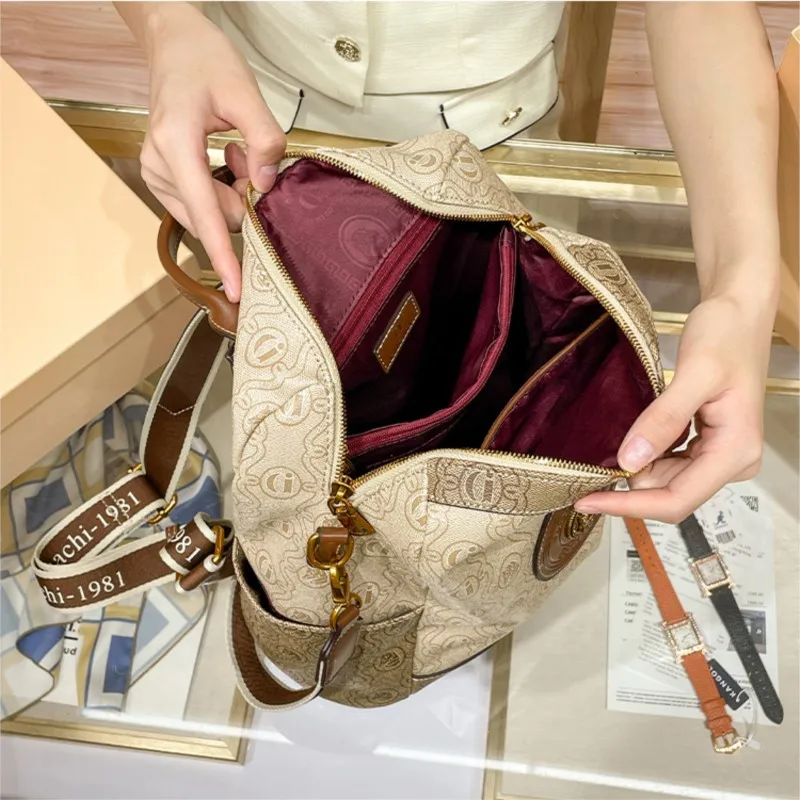
The most organized backpack serves little purpose if it looks out of place in your daily environments. Leather backpacks excel at bridging the gap between functionality and appropriate aesthetics.
Design Philosophy Spectrum
– Minimalist designs offer clean external appearances with sophisticated internal organization, ideal for professional settings where subtle elegance is valued
– Detailed designs with visible pockets and hardware provide quick access but present a more casual appearance
– Vintage-inspired styles often incorporate traditional elements like buckles and flaps, creating a timeless look that ages gracefully
– Modern interpretations feature sleek lines and innovative closure systems that balance heritage materials with contemporary function
Color Selection Strategy
– Classic black provides maximum versatility across formal and casual environments
– Rich browns develop character through patina development while remaining professionally appropriate
– Tan and cognac colors showcase natural grain variations and aging characteristics
– Darker colors typically show less wear and require less frequent cleaning
Leather Character Development
Quality leather transforms with use, developing a patina that enhances its appearance over time. Full-grain leather displays the most dramatic and appealing character development, with natural oils from handling creating deeper coloration in frequently touched areas. This evolution makes a well-used leather backpack more attractive rather than worn—a unique advantage over synthetic materials.
Adaptability Across Contexts
The versatility of leather allows a single well-chosen backpack to serve multiple environments. For maximum adaptability, look for designs with clean lines and minimal external branding. Office-appropriate leather backpacks typically feature more structured silhouettes and subdued hardware that won’t distract in meeting rooms.
When selecting a style, consider your most frequent environments and choose a design that feels appropriate in the most formal of these settings—leather’s natural adaptability will allow it to transition seamlessly to more casual contexts.
Security Features for Daily Peace of Mind
Organization extends beyond efficient arrangement to include protecting your valuables. Modern leather backpacks incorporate various security features that preserve both peace of mind and quick access to essentials.
Access Prevention Features
– Lockable zipper systems with discreet reinforced loops for travel locks
– Hidden compartment designs that place valuables against your back
– Strategic pocket placement that deters opportunistic theft
Positioning Security
– Body-side access pockets that can only be opened when the bag is removed
– RFID blocking technology integrated into dedicated card and passport pockets
– Concealed valuables storage between layers of the bag’s construction
Balancing Security and Convenience
Effective security doesn’t require sacrificing quick access. Consider a layered approach where frequently used items remain easily accessible while valuables receive additional protection. Some of the most secure designs maintain a deceptively simple appearance while incorporating sophisticated protection features.
When assessing security features, consider your typical environments and threat levels. Urban commuters might prioritize anti-theft features, while those in more controlled settings might focus on organizational security that prevents items from falling out during transit.
Remember that visible organization can sometimes create security vulnerabilities by making valuable contents obvious. The best security systems protect your belongings without advertising their presence.
Care and Maintenance for Longevity and Performance
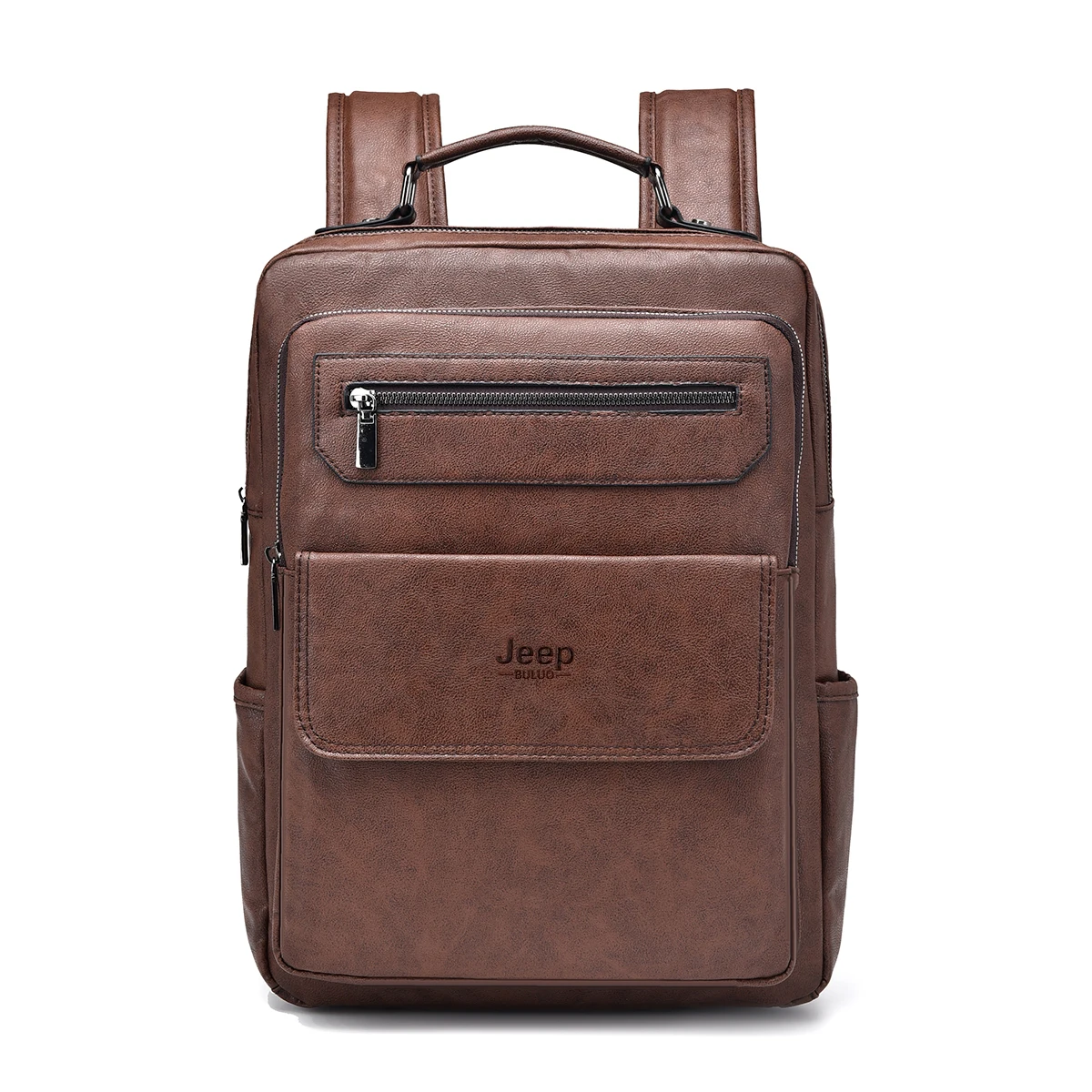
A well-maintained leather backpack continues to provide effective organization for many years, while neglected leather can lose structural integrity and organizational functionality.
Regular Maintenance Routine
– Dust removal with a soft cloth before and after extended use
– Cleaning appropriate to leather type (damp cloth for finished leather, specialized cleaners for suede)
– Conditioning every 3-6 months depending on climate and usage intensity
– Storage with light stuffing to maintain shape when not in use for extended periods
Environmental Protection Strategies
– Water protection through appropriate leather conditioners and waxes
– Avoiding prolonged direct sunlight that can dry and fade leather
– Preventing extreme temperature exposure that can crack leather or damage hardware
Addressing Common Issues
– Minor scratches often resolve with gentle finger buffing using natural skin oils
– Deeper scratches may require appropriate leather conditioner or polish
– Hardware maintenance using metal-specific cleaners to prevent corrosion
– Immediate attention to spills or stains using appropriate leather-safe cleaning methods
Developing a simple leather maintenance routine for commuters helps preserve both the aesthetic appeal and functional organization of your backpack. The few minutes invested in maintenance each month pays dividends in extended lifespan and preserved functionality of organizational features.
Remember that different leather types require specific care approaches. Full-grain vegetable-tanned leather benefits from different conditioning products than chrome-tanned leather. Always follow manufacturer recommendations for your specific backpack.
Budget Considerations: Value Assessment Beyond Price Tag
When investing in a leather backpack for daily organization, understanding the relationship between price and value helps make informed decisions:
Price Range Expectations
– Entry-level genuine leather backpacks: $100-$200
– Quality top-grain leather with good organization: $200-$350
– Premium full-grain leather with excellent craftsmanship: $350-$600+
– Luxury designer options: $600-$2,000+
Cost-Per-Use Analysis
A $400 full-grain leather backpack used daily for 10 years costs approximately $0.11 per use—significantly less than replacing lower-quality bags multiple times during the same period. This calculation doesn’t even account for the superior organizational benefits and professional presentation that quality leather provides.
Hidden Costs of Lower Quality
Less expensive options often incur additional costs through:
– Premature replacement when organizational features fail
– Repairs to failed zippers or torn compartments
– Professional appearance costs when bags look worn prematurely
– Damage to contents when protective features deteriorate
For those seeking the pinnacle of organizational functionality with uncompromising materials, luxury leather backpacks offer advanced features and exceptional craftsmanship. However, diminishing returns begin above certain price points where increases in cost reflect brand prestige more than organizational improvements.
The wisest approach balances quality with practical needs. For daily organization, investing in genuine quality rather than stretching to luxury levels often provides the best balance of performance and value.
Common Mistakes to Avoid When Selecting Your Leather Backpack
Even with careful research, several common pitfalls can lead to organizational dissatisfaction:
Prioritization Errors
– Choosing style over appropriate organization, resulting in beautiful but impractical bags
– Selecting inappropriate size (usually too large) based on occasional rather than daily needs
– Compromising on leather quality for minor cost savings, leading to premature deterioration
Technical Assessment Oversights
– Focusing exclusively on leather quality while ignoring hardware durability
– Overlooking stitching quality, particularly at stress points and organizational dividers
– Failing to test comfort when loaded with typical daily items
– Not checking accessibility of frequently used pockets and compartments
Usage Misalignment
– Selecting features designed for travel rather than daily organization
– Choosing inappropriate professional styling based on aspirational rather than actual workplace environments
– Underestimating maintenance requirements for certain leather types
Prevention Strategies
Before finalizing a purchase, visualize your specific daily items placed in each compartment. Consider access sequences for your most frequently used items. If possible, test the backpack with your actual daily carry items rather than relying on empty bag assessments.
Remember that the most beautiful backpack fails if it doesn’t organize your specific daily needs effectively. Organization must drive aesthetic choices rather than the reverse for daily use bags.
Balancing Personal and Professional Organization Needs
14 Inch Leather Laptop Backpack, Brown Leather Backpack, Men's Leather Backpack, Vintage Leather Backpack
Price range: $177.28 through $199.12 Select options This product has multiple variants. The options may be chosen on the product pageCarry On Leather Backpack, Roll Top Leather Backpack
Price range: $77.76 through $96.48 Select options This product has multiple variants. The options may be chosen on the product pageDesigner Men's Backpack, Men's Leather Laptop Backpack, Men's Leather Work Backpack
Price range: $158.04 through $160.04 Select options This product has multiple variants. The options may be chosen on the product pageDesigner Mini Backpack, Mini Leather Backpack, Small Leather Sling Backpack, Women's Leather Backpack
Price range: $95.76 through $98.80 Select options This product has multiple variants. The options may be chosen on the product pageDesigner Mini Backpack, Designer Women's Backpack, Mini Leather Backpack, Women's Leather Backpack
Price range: $135.92 through $137.64 Select options This product has multiple variants. The options may be chosen on the product page15 Inch Leather Laptop Backpack, Leather Briefcase Backpack
$332.96 Select options This product has multiple variants. The options may be chosen on the product page
Creating a leather backpack organization system that transitions seamlessly between personal and professional contexts requires thoughtful planning:
Dual-Purpose Organization Strategies
– Dedicated zones for work items (laptop, documents, business cards) versus personal items (wallet, keys, snacks)
– Color-coded pouches or organizers that visually separate different contexts
– Quick-swap organizational inserts that can transform your backpack from work to weekend mode
Specialized Professional Considerations
– Legal professionals benefit from document-focused organizational systems with file-compatible dimensions
– Creative professionals need protected storage for tablets, styluses, and specialty tools with quick access features
– Business professionals require presentation-ready organization that allows materials to emerge unwrinkled and properly arranged
Lifestyle Integration
– Gym/workout integration through moisture-resistant dedicated compartments
– Travel adaptability with security features that protect documents and valuables
– Weekend conversion strategies that transform formal organizational systems for casual use
The most effective organizational systems allow context-switching without complete repacking. For example, a well-designed backpack might feature a removable laptop sleeve that can be extracted for meetings while personal items remain in the main compartment.
For those whose organizational needs vary significantly between contexts, modular leather backpack designs offer adaptable systems that can be reconfigured rather than compromised.
How Does Leather Backpack Organization Compare to Other Materials?
Understanding the organizational differences between material types helps clarify leather’s specific advantages:
| Material | Structural Support | Durability | Organization Potential | Professional Perception |
|---|---|---|---|---|
| Leather | Excellent natural structure maintains organizational integrity | Very high with proper care | Superior internal structure supports sophisticated systems | Highest professional perception |
| Canvas | Moderate structure requires additional framing | Good with reinforcement | Requires internal structure for advanced organization | Casual to business-casual depending on design |
| Nylon/Synthetic | Minimal natural structure | Variable based on quality | Highly dependent on construction rather than material properties | Generally casual with limited professional acceptance |
Leather’s natural structure allows organizational systems to maintain their integrity without excessive reinforcement. Internal dividers stay upright, pockets retain their shape, and the overall bag maintains its form even when partially empty.
While canvas and synthetic materials can provide reasonable organization with proper design, they typically require more structural elements to achieve similar results. These additional frames and supports often add weight without contributing to durability.
Hybrid materials can offer interesting compromises—leather-trimmed canvas combines leather’s structural advantages at stress points with canvas’s lighter weight, creating organizational systems that balance multiple priorities.
Can a Leather Backpack Be Both Stylish and Highly Organized?
The perceived tension between style and organization represents a false dichotomy when it comes to quality leather backpacks. The best designs resolve this apparent conflict through thoughtful integration.
External simplicity often conceals internal complexity in well-designed leather backpacks. Clean lines and minimal visible hardware create professional aesthetics while sophisticated interior organizational systems remain hidden until needed. This approach allows for business-appropriate appearances without sacrificing functional organization.
The concept of “quiet luxury” applies particularly well to organizational leather goods—pieces that demonstrate their quality through materials and craftsmanship rather than obvious branding or decorative elements. This design philosophy creates backpacks that organize effectively while maintaining understated elegance.
Summit Carry’s design approach exemplifies this balanced philosophy, with exteriors that present clean professional lines while interiors reveal thoughtfully arranged organizational systems specifically designed for modern professionals.
Are There Ethical Considerations When Choosing Leather Backpacks?
Making informed choices about leather goods includes understanding their ethical implications:
Sourcing transparency: Reputable manufacturers provide information about leather origins and tanning processes, allowing consumers to make aligned choices.
Sustainable production: Traditional vegetable tanning uses plant-based materials rather than chromium compounds, reducing environmental impact.
Longevity as sustainability: Quality leather goods that last decades represent more sustainable choices than products requiring frequent replacement.
Ethical alternatives: For those concerned about traditional leather, options include upcycled leather (reclaimed from discarded products) and high-quality plant-based alternatives.
Lifetime value: Products designed for repair rather than replacement reduce overall resource consumption.
The environmental case for quality leather centers on longevity—a well-made leather backpack might replace five or more synthetic bags over its lifetime, potentially reducing overall environmental impact despite higher initial resource investment.
When evaluating options, look for transparency in the supply chain and commitment to quality construction that maximizes product lifespan. Certifications like Leather Working Group (LWG) can provide additional assurance about environmental practices.


